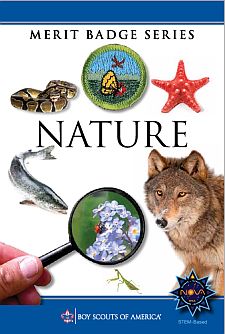A new printing of the Nature merit badge pamphlet with a new (added) requirement was released in 2020.
Since it was issued after the 2020 edition of Scouts BSA
Requirements was published,
Scouts starting the merit badge in 2020 could use either these
requirements, or the previous requirements
Furthermore, since the 2022 edition of Scouts BSA Requirements did NOT
include this requirement,
nor was it listed on Scouting.org in 2021 nor 2022, Scouts could continue to use either set
of requirements until 2023.
- Name three ways in which plants are important to animals. Name a plant that is important to animals that is protected in your state or region, and explain why it is at risk.
- Name three ways in which animals are important to plants. Name an animal that is protected in your state or region, and explain why it is at risk.
- Explain the term "food chain." Give an example of a four-step land food chain and a four-step water food chain.
- Do all the requirements in FIVE of the following fields:
- BIRDS
- In the field, identify eight species of birds.
- Make and set out a birdhouse OR a feeding station OR a birdbath. List what birds used it during a period of one month.
- MAMMALS
- In the field, identify three species of wild mammals.
- Make plaster casts of the tracks of a wild mammal.
- REPTILES and AMPHIBIANS
- Show that you can recognize the venomous snakes in your area.
- In the field, identify three species of reptiles or amphibians.
- Recognize one species of toad or frog by voice;
OR identify one reptile or amphibian by eggs, den, burrow or other signs.
- INSECTS and SPIDERS
- Collect and identify either in the field or through photographs 10 species of insects or spiders.*
- Hatch an insect from the pupa or cocoon;
OR hatch adults from nymphs;
OR keep larvae until they form pupae or cocoons;
OR keep a colony of ants or bees through one season.
- FISH
- Identify two species of fish native to your area.
- Collect four kinds of animal food eaten by fish in the wild.
- MOLLUSKS AND CRUSTACEANS
- Identify five species of mollusks and crustaceans.
- Collect, mount, and label six shells.
- PLANTS
- In the field, identify 15 species of wild plants.
- Collect and label seeds of six plants;
OR the leaves of 12 plants.
- SOILS AND ROCKS
- Collect and identify soils found in different layers of a soil profile.
- Collect and identify five different types of rocks from your area..
- BIRDS
- Discuss the principle of Leave No Trace and how it relates to nature.
* Photos may be taken with your own equipment or gathered from other sources.
NOTE:
In most cases all specimens should be returned to the wild at the location of original capture after the requirements have been met. Check with your merit badge counselor for those instances where the return of these specimens would not be appropriate.
Under the Endangered Species Act of 1973, some plants and animals are or may be protected by federal law. The same ones and/or others may be protected by state law. Be sure that you do not collect protected species.
Your state may require that you purchase and carry a license to collect certain species. Check with the wildlife and fish and game official in your state regarding species regulations before you begin to collect.
BSA Advancement ID#:
78
Scoutbook ID#:
79
Requirements last updated in:
2021
Pamphlet Publication Number:
35922
Pamphlet Stock (SKU) Number:
650735
E-Book Stock (SKU) Number:
656056
Pamphlet Copyright Date:
2021
|
|||||||
Page updated on: December 23, 2022









